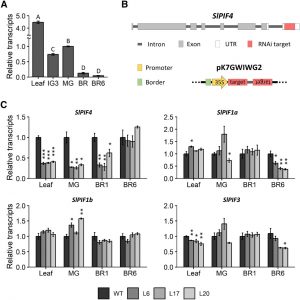Phytochrome-Interacting Factors and Tomato Qualities
Phytochromes (PHYs) are red/far-red light photoreceptors that are activated by light and deactivated by dark and high temperature. Upon  light exposure, PHYs are translocated into the nucleus, where they interact with PHY-INTERACTING FACTORS (PIFs) and induce the degradation of these transcription factors. Although the manipulation of light signals bears a great potential to influence fruit yield, so far, PIF studies in tomato (Solanum lycopersicum) have been limited to impacts on isoprenoid metabolism in fruits. Among the multiple PIF-encoding genes in the tomato genome, SlPIF1a, SlPIF1b, SlPIF3, and SlPIF4 showed the highest expression levels in seedlings, leaves, and fruits. Based on phylogenetic and transcriptional analyses, it has been proposed that SlPIF4 might have similar functions in the Arabidopsis orthologs AtPIF4 and AtPIF5. Therefore, SlPIF4 has the potential to regulate hypocotyl elongation, plant growth, flowering, and leaf senescence in response to light and temperature. Rosado et al. (10.1104/pp.19.00833) show that these functions are indeed shared by tomato, further strengthening the idea of the functional conservation of members of the PIF4 clade within angiosperms. To investigate the role of PIF4 in tomato, the authors investigated SlPIF4 expression under regular cultivation conditions. SlPIF4 expression dramatically decreased upon fruit ripening. Interestingly, SlPIF4-silenced fruits not only accumulated more carotenoids but also ripened faster than control fruits. SlPIF4-silencing also triggered a significant reduction in plant size, flowering, fruit yield, and fruit size. Besides confirming the functions previously described for PIF4, the results presented point to additional roles for this protein in the regulation of sugar partitioning, fruit production, and ripening. Overall, the pleiotropic effects observed in SlPIF4-silenced plants not only highlight the importance of PIFs in plant development, but also suggest that manipulation of light signaling is an efficient strategy to improve tomato yield and quality.
light exposure, PHYs are translocated into the nucleus, where they interact with PHY-INTERACTING FACTORS (PIFs) and induce the degradation of these transcription factors. Although the manipulation of light signals bears a great potential to influence fruit yield, so far, PIF studies in tomato (Solanum lycopersicum) have been limited to impacts on isoprenoid metabolism in fruits. Among the multiple PIF-encoding genes in the tomato genome, SlPIF1a, SlPIF1b, SlPIF3, and SlPIF4 showed the highest expression levels in seedlings, leaves, and fruits. Based on phylogenetic and transcriptional analyses, it has been proposed that SlPIF4 might have similar functions in the Arabidopsis orthologs AtPIF4 and AtPIF5. Therefore, SlPIF4 has the potential to regulate hypocotyl elongation, plant growth, flowering, and leaf senescence in response to light and temperature. Rosado et al. (10.1104/pp.19.00833) show that these functions are indeed shared by tomato, further strengthening the idea of the functional conservation of members of the PIF4 clade within angiosperms. To investigate the role of PIF4 in tomato, the authors investigated SlPIF4 expression under regular cultivation conditions. SlPIF4 expression dramatically decreased upon fruit ripening. Interestingly, SlPIF4-silenced fruits not only accumulated more carotenoids but also ripened faster than control fruits. SlPIF4-silencing also triggered a significant reduction in plant size, flowering, fruit yield, and fruit size. Besides confirming the functions previously described for PIF4, the results presented point to additional roles for this protein in the regulation of sugar partitioning, fruit production, and ripening. Overall, the pleiotropic effects observed in SlPIF4-silenced plants not only highlight the importance of PIFs in plant development, but also suggest that manipulation of light signaling is an efficient strategy to improve tomato yield and quality.



